TAMPOPO (1985)
A truck driver stops at a small family-run noodle shop and decides to help its fledgling business.
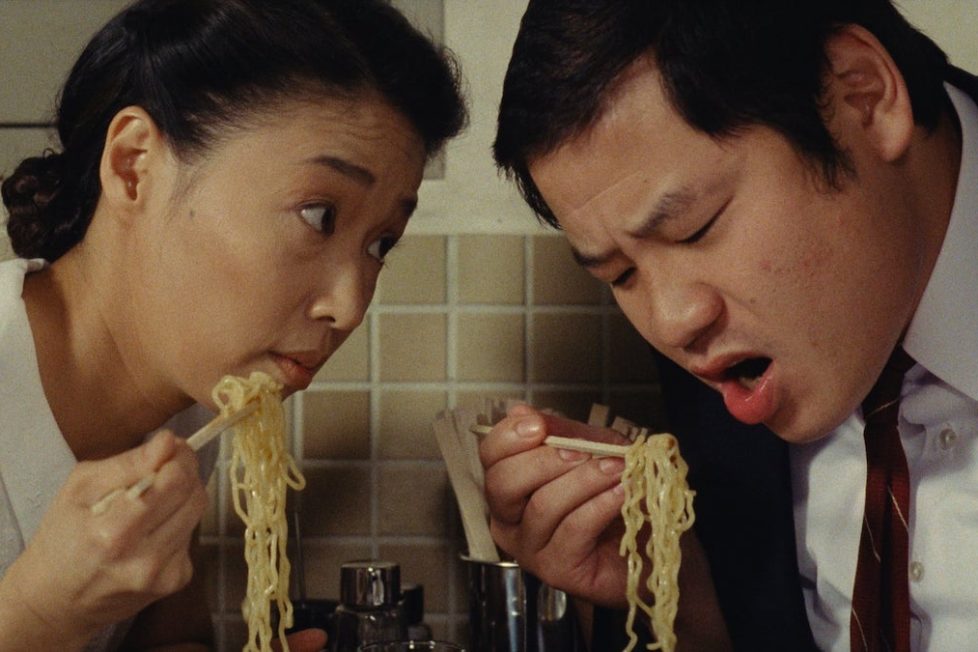
A truck driver stops at a small family-run noodle shop and decides to help its fledgling business.


Tampopo is a film about food, life, and everything in between. It’s passionate, sensual, and funny, encompassing all tastes. It’s also my favourite film about food. And I’m not alone. Alice Waters (food writer, chef, and founder of celebrated Californian restaurant Chez Pannisse) also thinks so, as it was recommended viewing for all her employees!
Tampopo is a genre all its own: the ‘Noodle Western’. It concerns one of Japan’s cheapest and tastiest foods—ramen—which is noodles in a broth with toppings that vary according to region and season. The word ‘tampopo’ is Japanese for ‘dandelion’, which is the name of the story’s heroine (Nobuko Miyamoto), a widow who’s inherited a run-down noodle joint. And the story truly begins when she’s inspired by a customer, lorry driver Goro (Tsutomu Yamazaki), whose name means ‘Bull’, to up her game and make it a thriving place of excellence.
The film follows Tampopo’s unconventional apprenticeship, interwoven with vignettes about other characters and their relationship with food, which affirms a love of life.
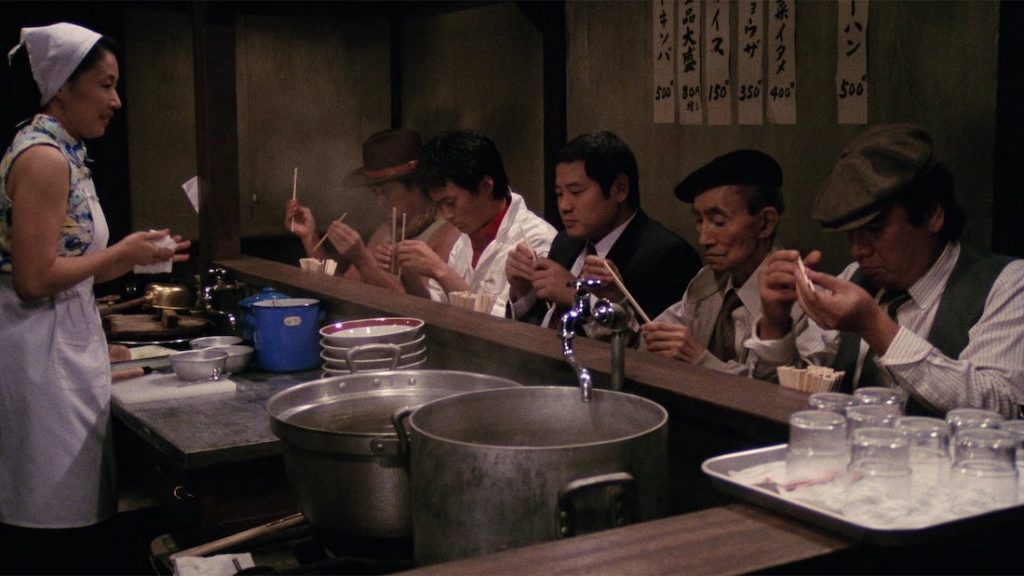
This was only the second feature from Juzo Itami, who became a director in his fifties after a career as a music manager and actor. His father, Mansanko Itami, had been a film director before World War II and made films about samurai, which satirised historical and modern Japanese society, so Juzo had avoided his father’s mantle for some time—probably because of a disjointed upbringing.
Juzo Itami was a child prodigy, chosen for ‘special scientific education’ during the war to assist in victory over the Allies. After WWII, he was moved to a more regular school and met his future brother-in-law, Kenzaburō Ōe, who later earned the Nobel Prize for Literature in 1994. At school, Itami read Rimbaud in the original French language, so it’s not surprising that there’s a strong Gallic influence in Tampopo.
Itami’s first film was The Funeral (1984), a satire on the elaborate funeral rites in Japan, which he made aged 50. It was a huge success, winning five Japanese Acting Academy ‘Oscars’—including ‘Best Film’ and ‘Best Director’. He could have made whatever he chose next, so was searching around for ideas when his wife advised him to do something he genuinely loved. And so, Tampopo, his love letter to food, began to take form.
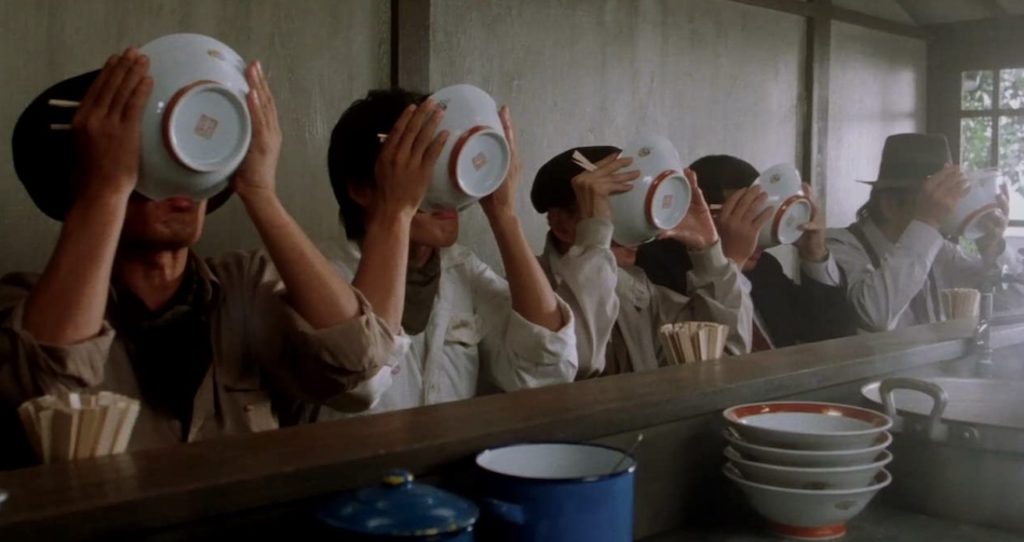
Itami worked up a complex screenplay based around the storyline of the classic western Shane (1953); with a mysterious stranger arriving into town (lorry driver Goro), who sorts everyone out, falls in love with the widow (Tampopo), helps her and her boy to a better life, but leaves so her childhood sweetheart (Pisuken) has a chance to woo her.
Of course, the template for many American westerns had already borrowed from Japanese films—Akira Kurosawa’s Yojimbo (1961) springs to mind, which was the inspiration for Sergio Leone’s A Fistful of Dollars (1965). Itami also looked to other Hollywood genres, a dash of noir, and a pinch of screwball, whilst borrowing from European cinema.
Itami worked into the script a series of disparate characters. There’s a white-suited gangster and his moll, passionate about food and each other, who open the film by sitting in a cinema while their henchmen sets up a feast for them. The gangster leans forward to address us, as fellow filmgoers, asking “whatcha eating?” to set the theme.
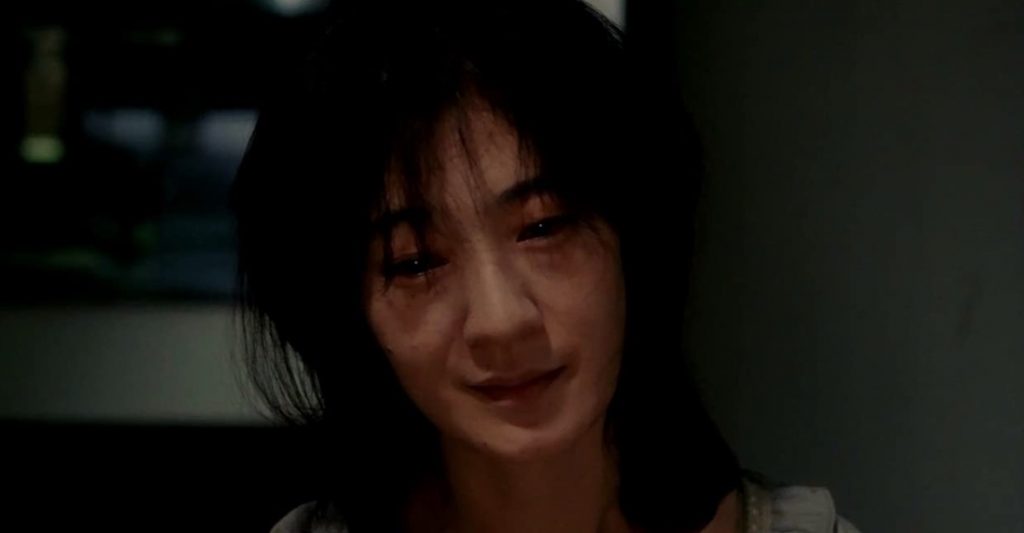
Later, we follow business executives who lunch at an expensive restaurant (look out for red faces), young ladies learning table manners, and a band of vagrant ‘foodies’. The camera follows these and others, floating like a dandelion seed through the city.
The film’s focus is on food and how it informs all our lives, while it fondly pokes fun at the Japanese for their elaborate rituals and precise codes of behaviour. Some may surprise western audiences! For example, to slurp noodles in Japan is a compliment to the chef, not a sign of bad manners. In the interests of authenticity, and the love of noodles, Itami and his wife toured the many ramen joints of Tokyo as research during the film’s development.
Itami’s wife, actress Nobuko Miyamoto, who also appeared in The Funeral, stars as the eponymous heroine, and his own son plays that part in the film. Tsutomu Yamazaki (also from The Funeral) plays Goro, the ‘cowboy’ lorry driver, while his sidekick Gun is played by Ken Watanabe—who went on to become an international star, appearing in many Hollywood films, including Inception (2010) and US reboot of Godzilla (2014).
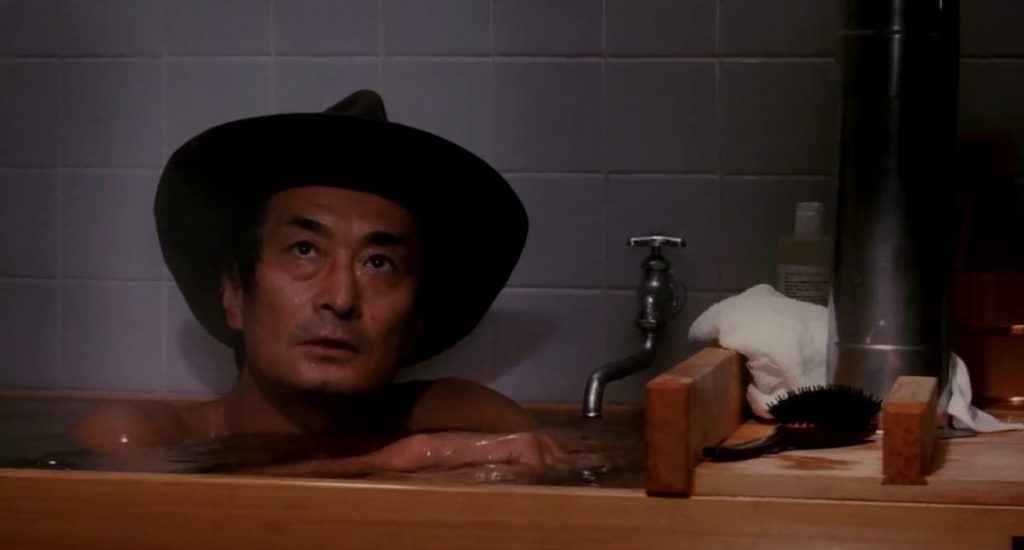
Itami was meticulous in bringing his vision to the screen. The costumes were carefully chosen and coordinated, the set for Tampopo’s ramen shop and locations around Tokyo—such as an abandoned road beneath a flyover for an epic Quiet Man (1952)-style fight scene—were selected from numerous options. To make them look their atmospheric best, a “rain specialist” was hired. One of the scenes was so convincingly set up that one passer by stopped to check whether ‘the man in the white suit’ (Kōji Hashimoto) was still alive after she heard shots! Visually, the film’s as harmonious as the flavours in a perfect dish, and credit has to go to cinematographer Masaki Tamura for that, who’d already won awards for his work on Farewell to the Land (1982) and went on to work on films such as Eureka (2000) which won awards at the Cannes Film festival.
The film also hired one of the first Film Food Stylists, Seiko Ogawa. She made bowl after bowl of ramen for Tampopo, which look so perfectly delicious on camera, while also catering for the actors in jury rigged kitchen.
For the perfect “Tokyo style” ramen depicted in the film, Ogawa prepared broth with flavour (from pork and chicken bones), but not too strong, using high quality soy sauce as seasoning. The noodles had to be boiled in a precise way and perfectly roast pork sliced for the topping. The shape of the bowl had be to just right for the ratio between broth and noodles, too. Ogawa tutored Nobuko Miyamoto in the technique of flipping the just cooked noodles into the bowls, until Miyamoto’s started to suffer from RSI in her wrists! Becoming a ramen master does require technique and stamina.
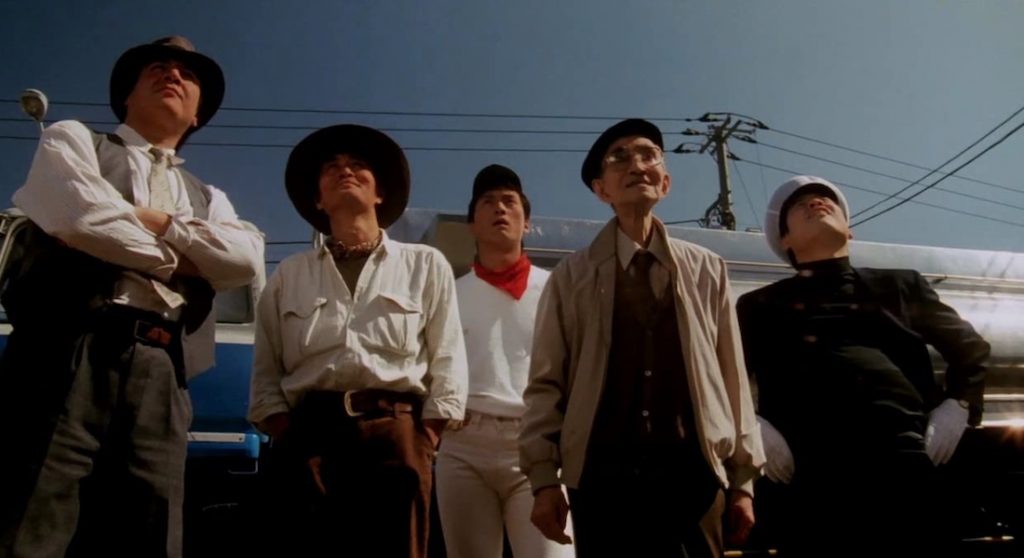
For the famous ‘egg yolk scene’, between the gangster and his moll, she researched a selection of the best free range eggs with the strongest membrane around the yolk, which Itami and his wife took home to research and decide upon. For the scene’s preparation, the actors wore kagools over their costumes in case things went wrong and the yolk broke too soon.
The scene worked well in the end, as did the seashore oyster scene (as oysters were out of season, the film stylist also had to locate the best oysters to ship in, and the best ‘shucking’ knife to use).
Apparently, the elaborate method described by ‘the ramen master’ in the film on how to eat ramen is Itami’s own—everyone has their own unique way to eat ramen, but it’s best to slurp the noodles before they go too starchy, then finish the broth!
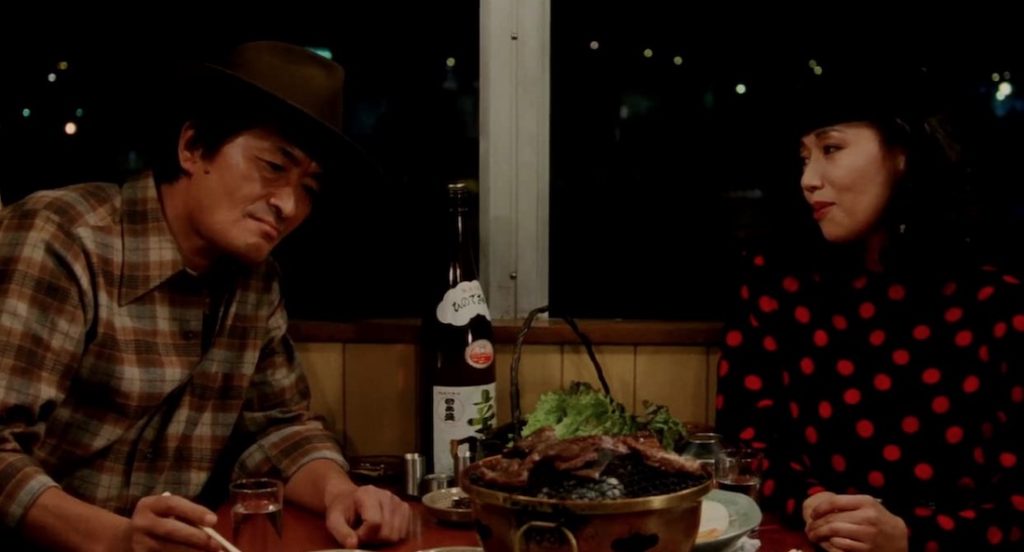
Tampopo is so charming and disarming, it swipes you with scenes of beauty and pathos and comedy. The stories are wide and varied: a business lunch where the most junior executive sacrifices deference to gastronomy; a tragic and tender last supper; an ode to a fresh oyster eaten on the seashore; a scene where a vagrant breaks into a hotel kitchen to fix an omelette smothered in tomato ketchup for Tampopo’s son.
There are erotic explorations of love of food and passion shared by the white-suited gangster and his moll. There’s even a comedic scene where an elegant old lady sneaks around an expensive supermarket handling the goods in an outrageous parody of everyone you’ve ever seen mauling shared food at a party before passing it on.
Tampopo’s tale is interwoven through all these vignettes and you’re rooting for her as she endures her Rocky-style training to become the ultimate ramen master! When Goro accepts the challenge to help her, he enlists his sidekick Gun as a fellow food critic, a vagrant who’s also a connoisseur, and the chef of a wealthy man they rescue from choking while dining at a restaurant.
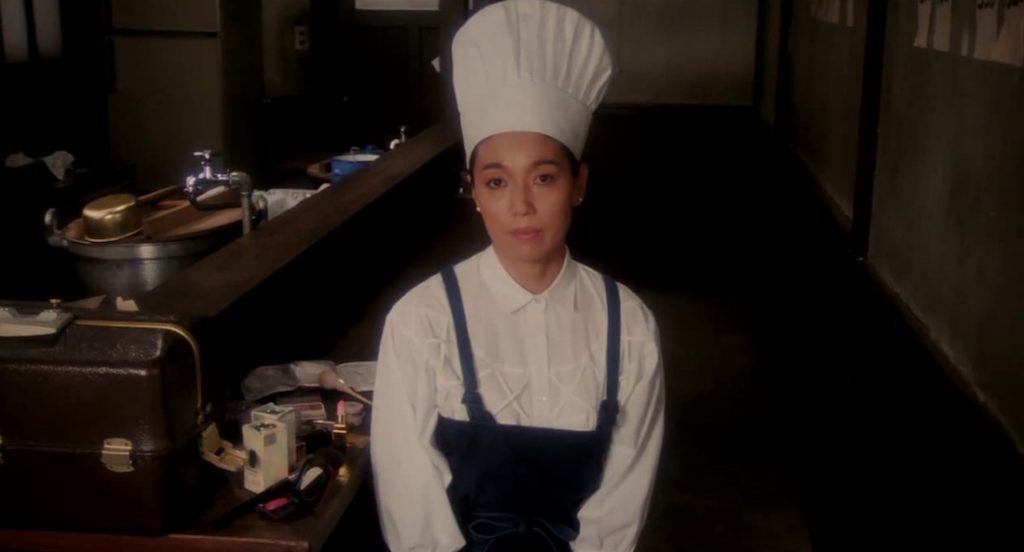
Ramen masters are usually men, apprenticed for many years to learn the trade before they can open a ramen shop of their own, so Tampopo’s crash course is transgressive and requires spying (even on dustbins outside rival noodle joints) and teasing information out of ramen masters.
The music score includes swells of classical orchestral music (Mahler’s First and Fifth symphonies, Liszt’s “Les Preludes”) which emphasise the passion required for Tampopo’s transformation. The choice of music is surprisingly effective, though not without a touch of irony.
Tampopo’s suitor Pisuken (Rikiya Yasuoka) re-fits her shop and Tampopo herself gets a stylish revamp. Goro objects to the last, as she is “already beautiful”, but he’s overruled. Finally, Goro and Tampopo go out for a meal to enjoy together, rather than to assess the competition. The pair share some romantic moments over Korean ribs instead of ramen!
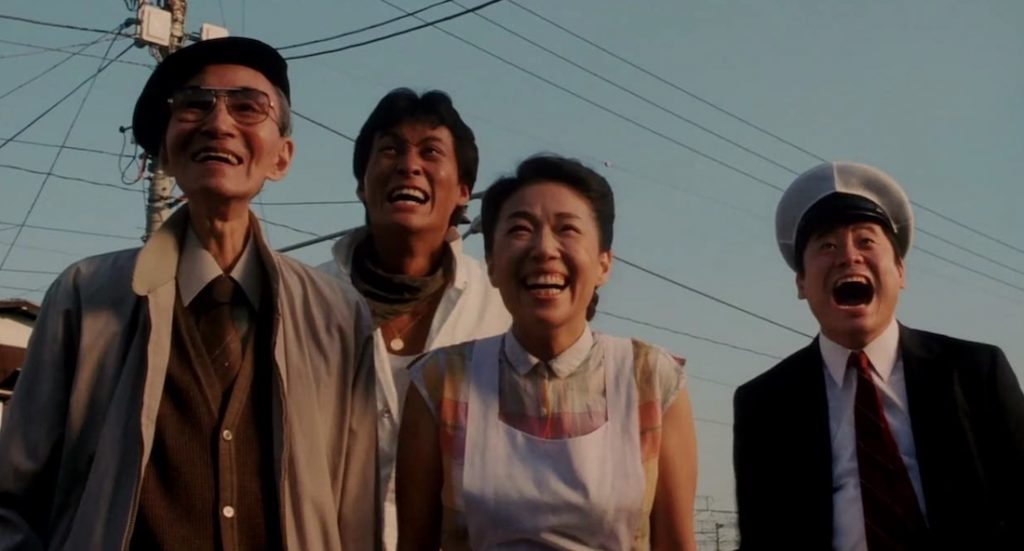
This is an aspirational movie to warm the heart, and when Goro and her other mentors finally slurp her ramen down to the last drop of broth as a heavenly sunbeam slants through the windows of her freshly re-styled shop, you share Tampopo’s exquisite satisfaction and pleasure in her achievement.
Although Tampopo didn’t achieve the same success as The Funeral in Japan, it went on to be more popular abroad. It was released in the US in 1987 to great critical acclaim. Roger Ebert compared it to Jacques Tati’s work for its comical, at times almost slapstick, approach. It also introduced Japanese cuisine to many westerners for the first time, and the ‘Noodle Western’ gained in popularity throughout the growing foodie community. There now exist quite a few noodle bars around the world named ‘Tampopo’.
Itami’s directing career remained steady. He made A Taxing Woman (1987) and A Taxing Woman’s Return (1988), both comedies which starring his wife as a female tax inspector. His other comedies included Golden Geisha (1990) and Supermarket Woman (1996). But it was Tampopo that assured his international reputation and became a cult classic. It even inspired a stylised remake starring Brittany Murphy, called The Ramen Girl (2008)!
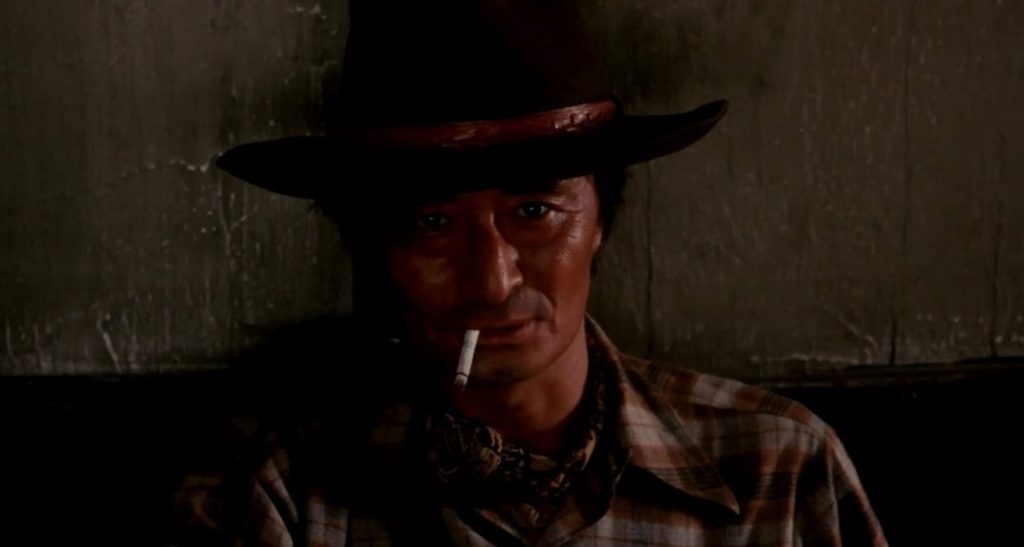
Tampopo has influenced many famous chefs, too, such as Alice Waters and Sam White (who opened his own successful ramen restaurant in California). Some American chefs made a pilgrimage to Japan and became apprentices to ramen masters in order to devise their own ‘perfect broth’.
Food is difficult to convey in cinema. There’s only a few films, like Babette’s Feast (1987), Julia and Julia (2009), and Chef! (2014) that have become classics. Tampopo is the best I’ve ever seen. A definitive Blu-ray of Tampopo was released as part of the Criterion Collection in 2016, with extras that included a touching interview with Nobuko Miyamoto, as Juzo Itami died in 1997. Tampopo was also listed in Steven Schneider’s 2014 book 1001 Movies You Must See Before You Die.
Tampopo remains a quirky film which riffs on American westerns, gangster films, French cinema, and yet remains unique in its own ‘Noodle Western’ genre. Watch it and you’ll be reaching for your next bowl of noodles, inspired to make it a superlative experience! It’s a definitive classic to watch periodically as an homage to food and to life. Tuck in and enjoy.
JAPAN | 1985 | 114 MINUTES | 1.37:1 | COLOUR | JAPANESE

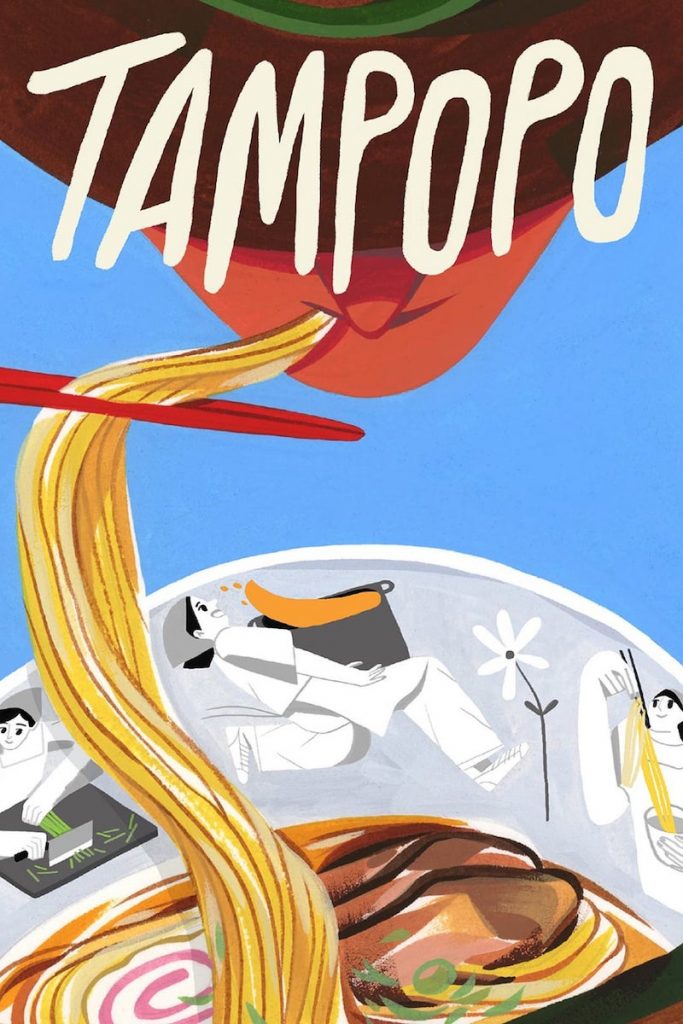
writer & director: Juzo Itami.
starring: Tsutomu Yamazaki, Nobuko Miyamoto, Kōji Yakusho, Ken Watanabe & Rikiya Yosuoka.
